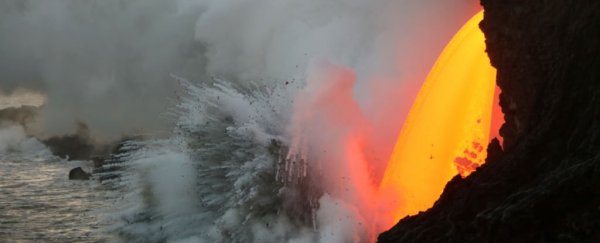There are plenty of amazing things in this world that you can read about in a textbook – think the pyramids, Pompeii, the Parthenon – but there are also plenty of strange places around the planet that you probably didn't learn about at school.
In fact, they're so weird, a lot of the time even scientists are only just beginning to wrap their heads around them. Here's a list of our favourites:
1. A mysterious boiling river straight out of Amazonian legend
If you've ever regretted getting into slightly hot bath water, you'll probably cringe at the realisation that there's a river hidden deep in the Amazon that is so hot it can actually burn skin.
But how does it work? Especially when there's no volcanoes in the area to boil the water?
After years of research, Peruvian geoscientist Andrés Ruzo thinks he has an answer - the heat could be coming from fault-fed hot springs.
2. This savage, bird-killing tree in the Seychelles
On Cousin Island in the Seychelles there's a species of tree known as Pisonia grandis, and it's not something you want to mess around with.
Although it photosynthesises like every other plant, its quirk is that it also has a taste for… killing things?
As Mike McRae explained for us earlier this year:
"What sets the Pisonia apart from other trees that use glue or prickles to hitch a ride is that these seeds can pile up rather quickly – especially if a bird falls or lands among the pods on the ground – weighing down smaller individuals and making it impossible for them to fly."
Researchers have hypothesised that the trees probably evolved the glue to hitch a ride on alive sea birds to spread their seed – but the tree just didn't care too much if it's happened to kill a few along the way.
Nature can be brutal.
3. There's a fire in Australia that's been burning for 6,000 years
You've probably already heard about the coal seam gas blaze beneath the now-abandoned town of Centralia in Pennsylvania, US - the town that the creepy video game and film Silent Hill was based on.
But the Centralia fire has only been burning for the past 53 years - a relative blink of an eye when you consider that in Australia, a similar coal seam blaze has been smouldering for an estimated 6,000 years, long before the continent was settled by Europeans.
No one is sure what first ignited the fire under Mount Wingen, or Burning Mountain, in the state of New South Wales.
But according to the stories of the traditional Wanaruah people, it's been used by Aboriginal groups for thousands of years for warmth, cooking, and to help make tools.
4. Hawaii's ridiculously active lava tubes
Hawaii is well-known for its dramatic landscapes and volcanic activity.
But things get a lot more brutal when land collapses in on itself and a giant spout of lava forms right in front of your eyes, pouring into the Pacific Ocean like a thick Bloody Mary.
That's what happened earlier this year when sea cliffs near Hawaii's Kilauea volcano collapsed, revealing a continuous stream of molten rock stretching up to 2 metres across at its widest point.
You can see it in action in the video below:

As of December 17, Kilauea Volcano continues to erupt, but it's not quite as spectacular as the footage above. Still, you never know when one of these active tubes will be exposed again, so don't get too close to the edge.
5. This tree in the Caribbean that you can't stand underneath when it rains
The Caribbean island of Tobago is a tropical paradise complete with idyllic, deserted beaches.
But in 1999, radiologist Nicola Strickland went on a holiday there, and she and her friend found some sweet-smelling green fruit that looked like crabapples.
Both decided to take a bite, and within moments the sweet taste was overwhelmed by a peppery, burning feeling and an excruciating tightness in the throat.
According to the Guinness World Records, this tree, called a manchineel tree (Hippomane mancinella) is in fact the most dangerous in the world.
One of the tree's toxins, known as phorbol, is highly water soluble, so you can't even stand underneath the tree when it rains without being burnt by the toxin. In fact, Christopher Columbus apparently described the fruit as 'death apples'. Pleasant.
